Critical Analysis of the Project Management Plan (PMP) Report
VerifiedAdded on 2023/06/05
|15
|4669
|431
Report
AI Summary
This report presents a critical analysis of a Project Management Plan (PMP) for a local government reform project involving the amalgamation of the City of Swan and Shire of Mundaring. The analysis covers various aspects of the PMP, including project scope and management, deliverables and milestones, assumptions, constraints, dependencies, benefits and outcomes, cost management, procurement, schedule, change control, quality management, risk management, human resources, project reporting, communication, and project integration. The report identifies areas for improvement within the PMP, offering recommendations based on the review. It examines the plan's structure, completeness, and effectiveness in addressing key project management elements, providing insights into potential enhancements for successful project execution. The report concludes with recommendations for strengthening the PMP and ensuring the successful transition to the new local government entity.
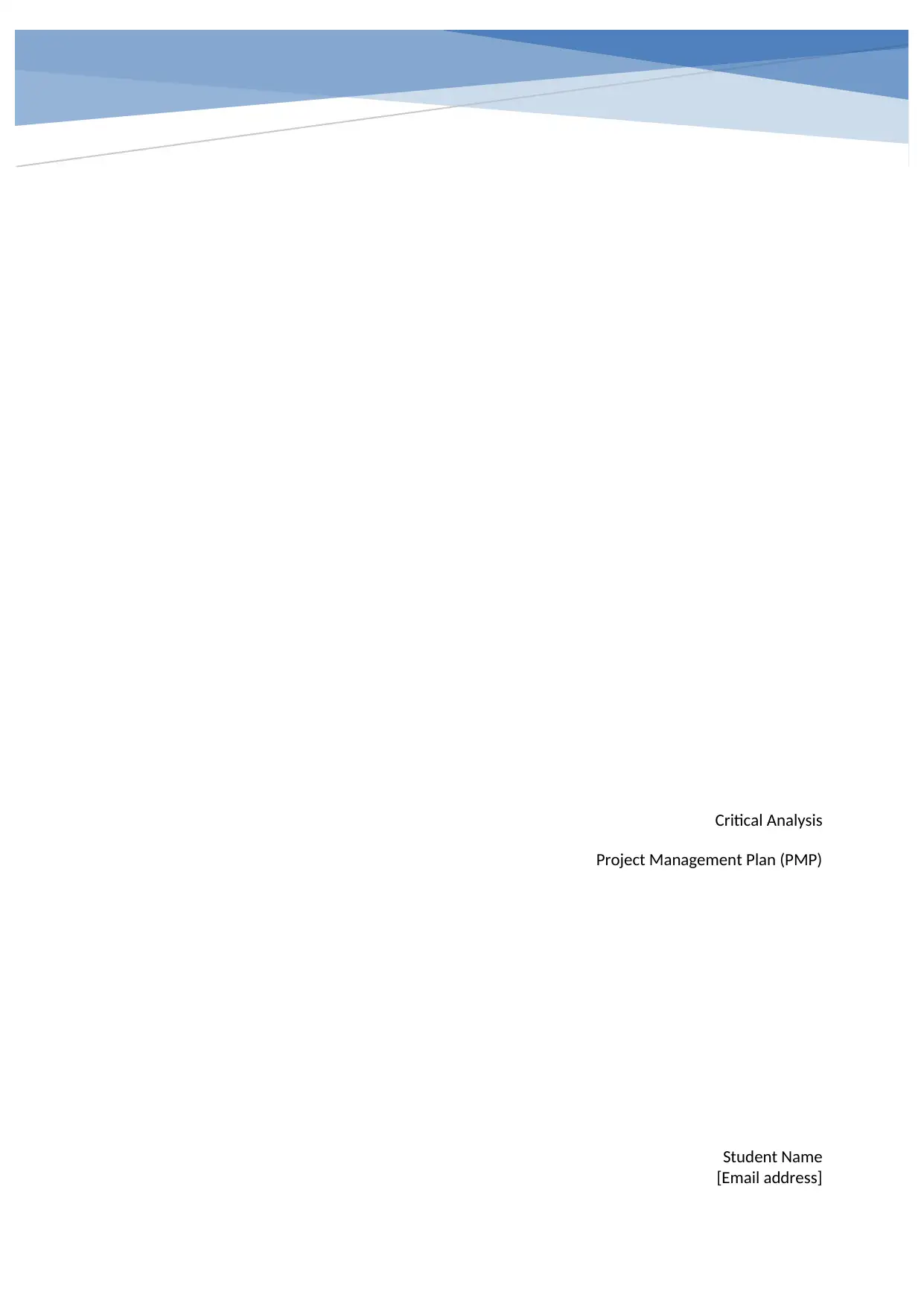
Critical Analysis
Project Management Plan (PMP)
Student Name
[Email address]
Project Management Plan (PMP)
Student Name
[Email address]
Paraphrase This Document
Need a fresh take? Get an instant paraphrase of this document with our AI Paraphraser

Critical Analysis
Critical Analysis
Project Management Plan (PMP)
10/11/2018
1
Critical Analysis
Project Management Plan (PMP)
10/11/2018
1
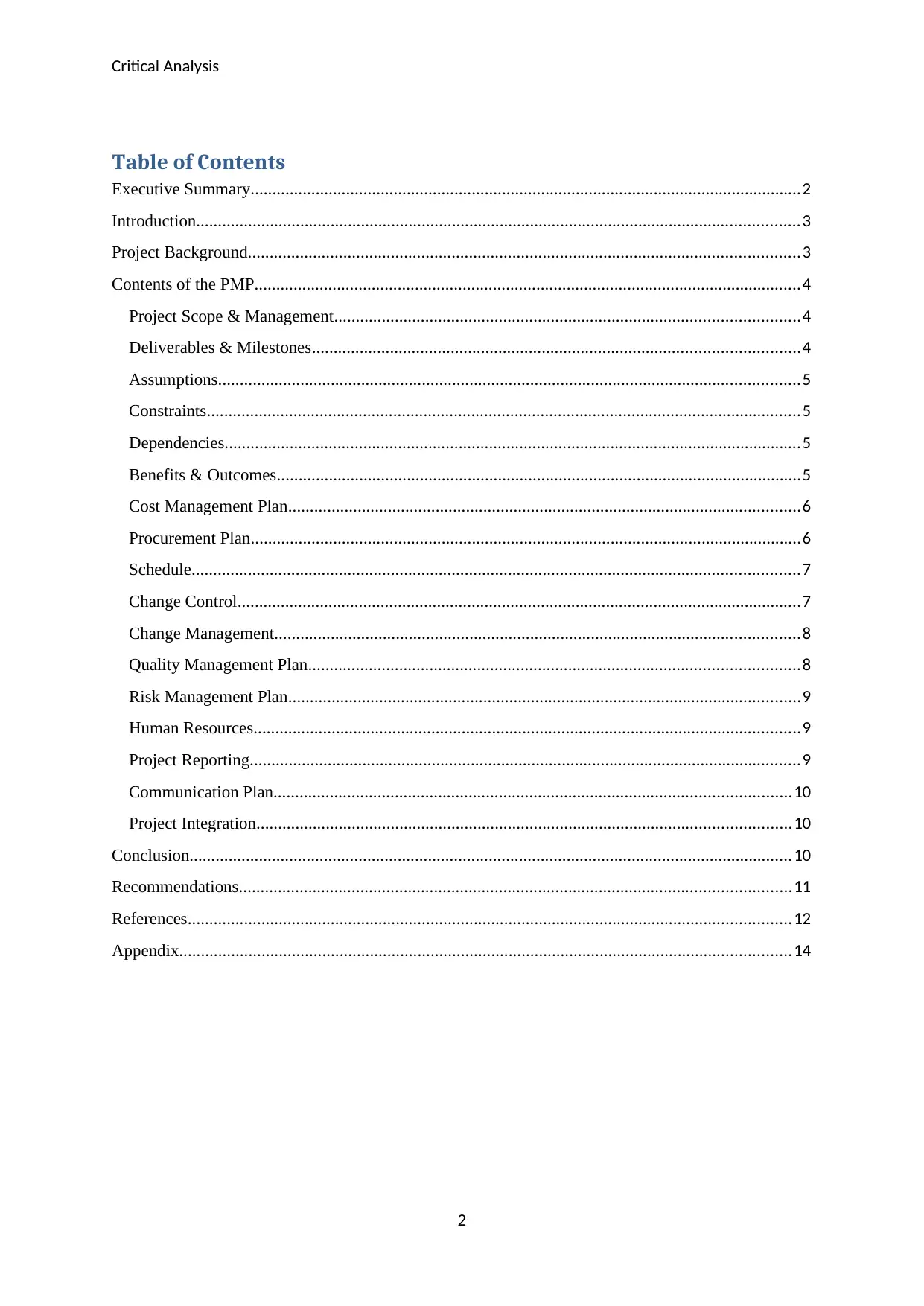
Critical Analysis
Table of Contents
Executive Summary...............................................................................................................................2
Introduction...........................................................................................................................................3
Project Background...............................................................................................................................3
Contents of the PMP..............................................................................................................................4
Project Scope & Management...........................................................................................................4
Deliverables & Milestones................................................................................................................4
Assumptions......................................................................................................................................5
Constraints.........................................................................................................................................5
Dependencies.....................................................................................................................................5
Benefits & Outcomes.........................................................................................................................5
Cost Management Plan......................................................................................................................6
Procurement Plan...............................................................................................................................6
Schedule............................................................................................................................................7
Change Control..................................................................................................................................7
Change Management.........................................................................................................................8
Quality Management Plan.................................................................................................................8
Risk Management Plan......................................................................................................................9
Human Resources..............................................................................................................................9
Project Reporting...............................................................................................................................9
Communication Plan.......................................................................................................................10
Project Integration...........................................................................................................................10
Conclusion...........................................................................................................................................10
Recommendations...............................................................................................................................11
References...........................................................................................................................................12
Appendix.............................................................................................................................................14
2
Table of Contents
Executive Summary...............................................................................................................................2
Introduction...........................................................................................................................................3
Project Background...............................................................................................................................3
Contents of the PMP..............................................................................................................................4
Project Scope & Management...........................................................................................................4
Deliverables & Milestones................................................................................................................4
Assumptions......................................................................................................................................5
Constraints.........................................................................................................................................5
Dependencies.....................................................................................................................................5
Benefits & Outcomes.........................................................................................................................5
Cost Management Plan......................................................................................................................6
Procurement Plan...............................................................................................................................6
Schedule............................................................................................................................................7
Change Control..................................................................................................................................7
Change Management.........................................................................................................................8
Quality Management Plan.................................................................................................................8
Risk Management Plan......................................................................................................................9
Human Resources..............................................................................................................................9
Project Reporting...............................................................................................................................9
Communication Plan.......................................................................................................................10
Project Integration...........................................................................................................................10
Conclusion...........................................................................................................................................10
Recommendations...............................................................................................................................11
References...........................................................................................................................................12
Appendix.............................................................................................................................................14
2
⊘ This is a preview!⊘
Do you want full access?
Subscribe today to unlock all pages.

Trusted by 1+ million students worldwide
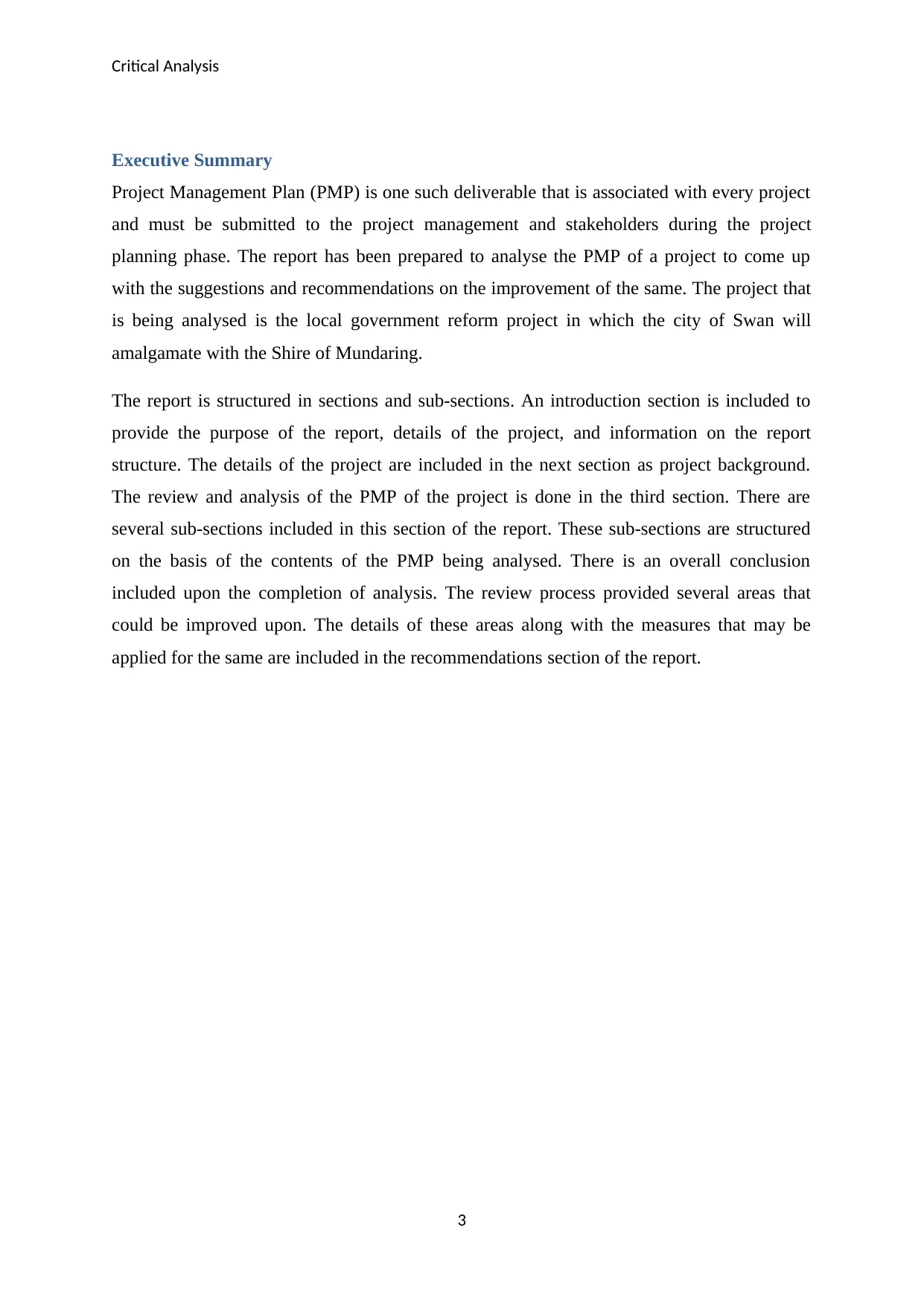
Critical Analysis
Executive Summary
Project Management Plan (PMP) is one such deliverable that is associated with every project
and must be submitted to the project management and stakeholders during the project
planning phase. The report has been prepared to analyse the PMP of a project to come up
with the suggestions and recommendations on the improvement of the same. The project that
is being analysed is the local government reform project in which the city of Swan will
amalgamate with the Shire of Mundaring.
The report is structured in sections and sub-sections. An introduction section is included to
provide the purpose of the report, details of the project, and information on the report
structure. The details of the project are included in the next section as project background.
The review and analysis of the PMP of the project is done in the third section. There are
several sub-sections included in this section of the report. These sub-sections are structured
on the basis of the contents of the PMP being analysed. There is an overall conclusion
included upon the completion of analysis. The review process provided several areas that
could be improved upon. The details of these areas along with the measures that may be
applied for the same are included in the recommendations section of the report.
3
Executive Summary
Project Management Plan (PMP) is one such deliverable that is associated with every project
and must be submitted to the project management and stakeholders during the project
planning phase. The report has been prepared to analyse the PMP of a project to come up
with the suggestions and recommendations on the improvement of the same. The project that
is being analysed is the local government reform project in which the city of Swan will
amalgamate with the Shire of Mundaring.
The report is structured in sections and sub-sections. An introduction section is included to
provide the purpose of the report, details of the project, and information on the report
structure. The details of the project are included in the next section as project background.
The review and analysis of the PMP of the project is done in the third section. There are
several sub-sections included in this section of the report. These sub-sections are structured
on the basis of the contents of the PMP being analysed. There is an overall conclusion
included upon the completion of analysis. The review process provided several areas that
could be improved upon. The details of these areas along with the measures that may be
applied for the same are included in the recommendations section of the report.
3
Paraphrase This Document
Need a fresh take? Get an instant paraphrase of this document with our AI Paraphraser
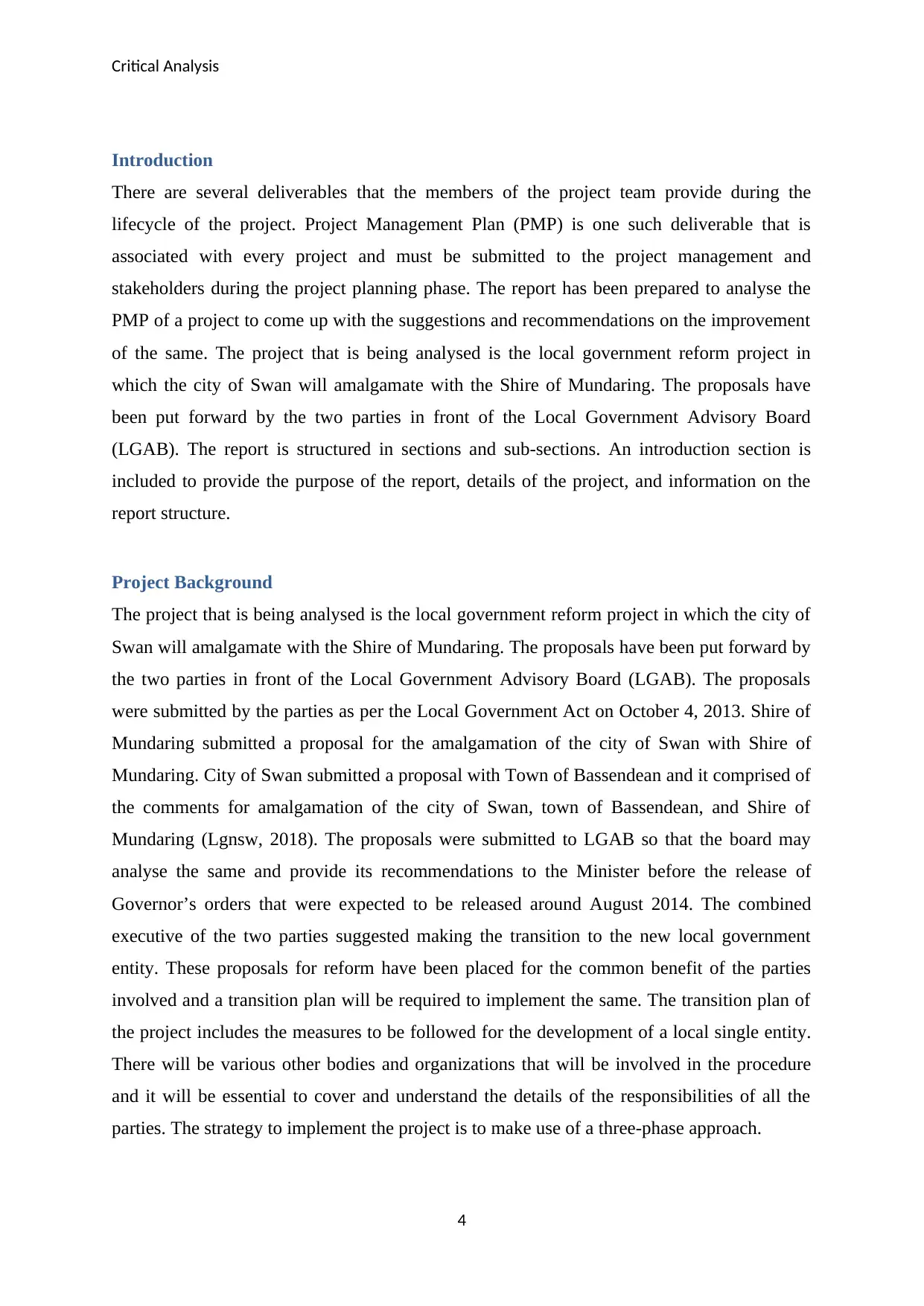
Critical Analysis
Introduction
There are several deliverables that the members of the project team provide during the
lifecycle of the project. Project Management Plan (PMP) is one such deliverable that is
associated with every project and must be submitted to the project management and
stakeholders during the project planning phase. The report has been prepared to analyse the
PMP of a project to come up with the suggestions and recommendations on the improvement
of the same. The project that is being analysed is the local government reform project in
which the city of Swan will amalgamate with the Shire of Mundaring. The proposals have
been put forward by the two parties in front of the Local Government Advisory Board
(LGAB). The report is structured in sections and sub-sections. An introduction section is
included to provide the purpose of the report, details of the project, and information on the
report structure.
Project Background
The project that is being analysed is the local government reform project in which the city of
Swan will amalgamate with the Shire of Mundaring. The proposals have been put forward by
the two parties in front of the Local Government Advisory Board (LGAB). The proposals
were submitted by the parties as per the Local Government Act on October 4, 2013. Shire of
Mundaring submitted a proposal for the amalgamation of the city of Swan with Shire of
Mundaring. City of Swan submitted a proposal with Town of Bassendean and it comprised of
the comments for amalgamation of the city of Swan, town of Bassendean, and Shire of
Mundaring (Lgnsw, 2018). The proposals were submitted to LGAB so that the board may
analyse the same and provide its recommendations to the Minister before the release of
Governor’s orders that were expected to be released around August 2014. The combined
executive of the two parties suggested making the transition to the new local government
entity. These proposals for reform have been placed for the common benefit of the parties
involved and a transition plan will be required to implement the same. The transition plan of
the project includes the measures to be followed for the development of a local single entity.
There will be various other bodies and organizations that will be involved in the procedure
and it will be essential to cover and understand the details of the responsibilities of all the
parties. The strategy to implement the project is to make use of a three-phase approach.
4
Introduction
There are several deliverables that the members of the project team provide during the
lifecycle of the project. Project Management Plan (PMP) is one such deliverable that is
associated with every project and must be submitted to the project management and
stakeholders during the project planning phase. The report has been prepared to analyse the
PMP of a project to come up with the suggestions and recommendations on the improvement
of the same. The project that is being analysed is the local government reform project in
which the city of Swan will amalgamate with the Shire of Mundaring. The proposals have
been put forward by the two parties in front of the Local Government Advisory Board
(LGAB). The report is structured in sections and sub-sections. An introduction section is
included to provide the purpose of the report, details of the project, and information on the
report structure.
Project Background
The project that is being analysed is the local government reform project in which the city of
Swan will amalgamate with the Shire of Mundaring. The proposals have been put forward by
the two parties in front of the Local Government Advisory Board (LGAB). The proposals
were submitted by the parties as per the Local Government Act on October 4, 2013. Shire of
Mundaring submitted a proposal for the amalgamation of the city of Swan with Shire of
Mundaring. City of Swan submitted a proposal with Town of Bassendean and it comprised of
the comments for amalgamation of the city of Swan, town of Bassendean, and Shire of
Mundaring (Lgnsw, 2018). The proposals were submitted to LGAB so that the board may
analyse the same and provide its recommendations to the Minister before the release of
Governor’s orders that were expected to be released around August 2014. The combined
executive of the two parties suggested making the transition to the new local government
entity. These proposals for reform have been placed for the common benefit of the parties
involved and a transition plan will be required to implement the same. The transition plan of
the project includes the measures to be followed for the development of a local single entity.
There will be various other bodies and organizations that will be involved in the procedure
and it will be essential to cover and understand the details of the responsibilities of all the
parties. The strategy to implement the project is to make use of a three-phase approach.
4
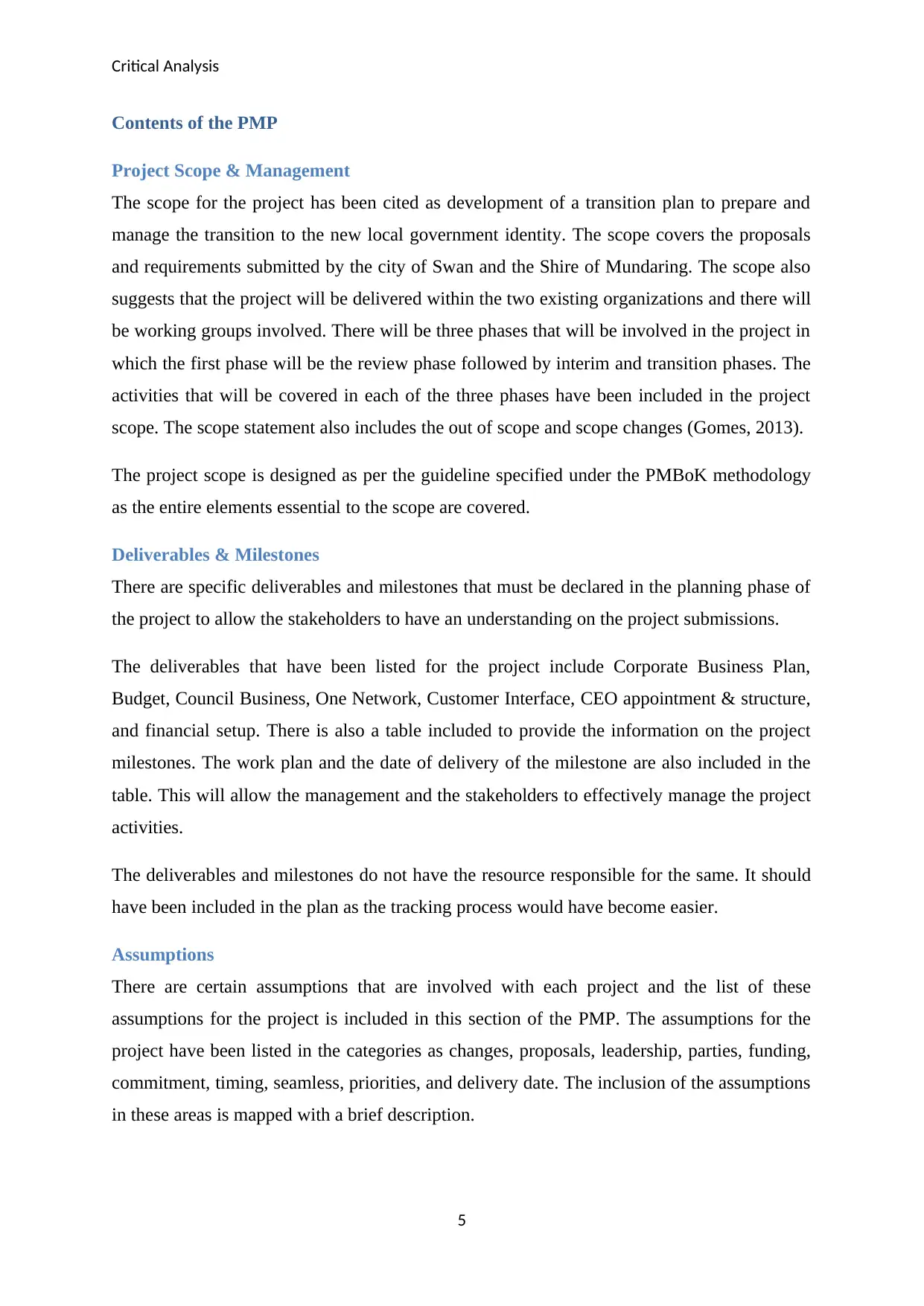
Critical Analysis
Contents of the PMP
Project Scope & Management
The scope for the project has been cited as development of a transition plan to prepare and
manage the transition to the new local government identity. The scope covers the proposals
and requirements submitted by the city of Swan and the Shire of Mundaring. The scope also
suggests that the project will be delivered within the two existing organizations and there will
be working groups involved. There will be three phases that will be involved in the project in
which the first phase will be the review phase followed by interim and transition phases. The
activities that will be covered in each of the three phases have been included in the project
scope. The scope statement also includes the out of scope and scope changes (Gomes, 2013).
The project scope is designed as per the guideline specified under the PMBoK methodology
as the entire elements essential to the scope are covered.
Deliverables & Milestones
There are specific deliverables and milestones that must be declared in the planning phase of
the project to allow the stakeholders to have an understanding on the project submissions.
The deliverables that have been listed for the project include Corporate Business Plan,
Budget, Council Business, One Network, Customer Interface, CEO appointment & structure,
and financial setup. There is also a table included to provide the information on the project
milestones. The work plan and the date of delivery of the milestone are also included in the
table. This will allow the management and the stakeholders to effectively manage the project
activities.
The deliverables and milestones do not have the resource responsible for the same. It should
have been included in the plan as the tracking process would have become easier.
Assumptions
There are certain assumptions that are involved with each project and the list of these
assumptions for the project is included in this section of the PMP. The assumptions for the
project have been listed in the categories as changes, proposals, leadership, parties, funding,
commitment, timing, seamless, priorities, and delivery date. The inclusion of the assumptions
in these areas is mapped with a brief description.
5
Contents of the PMP
Project Scope & Management
The scope for the project has been cited as development of a transition plan to prepare and
manage the transition to the new local government identity. The scope covers the proposals
and requirements submitted by the city of Swan and the Shire of Mundaring. The scope also
suggests that the project will be delivered within the two existing organizations and there will
be working groups involved. There will be three phases that will be involved in the project in
which the first phase will be the review phase followed by interim and transition phases. The
activities that will be covered in each of the three phases have been included in the project
scope. The scope statement also includes the out of scope and scope changes (Gomes, 2013).
The project scope is designed as per the guideline specified under the PMBoK methodology
as the entire elements essential to the scope are covered.
Deliverables & Milestones
There are specific deliverables and milestones that must be declared in the planning phase of
the project to allow the stakeholders to have an understanding on the project submissions.
The deliverables that have been listed for the project include Corporate Business Plan,
Budget, Council Business, One Network, Customer Interface, CEO appointment & structure,
and financial setup. There is also a table included to provide the information on the project
milestones. The work plan and the date of delivery of the milestone are also included in the
table. This will allow the management and the stakeholders to effectively manage the project
activities.
The deliverables and milestones do not have the resource responsible for the same. It should
have been included in the plan as the tracking process would have become easier.
Assumptions
There are certain assumptions that are involved with each project and the list of these
assumptions for the project is included in this section of the PMP. The assumptions for the
project have been listed in the categories as changes, proposals, leadership, parties, funding,
commitment, timing, seamless, priorities, and delivery date. The inclusion of the assumptions
in these areas is mapped with a brief description.
5
⊘ This is a preview!⊘
Do you want full access?
Subscribe today to unlock all pages.

Trusted by 1+ million students worldwide
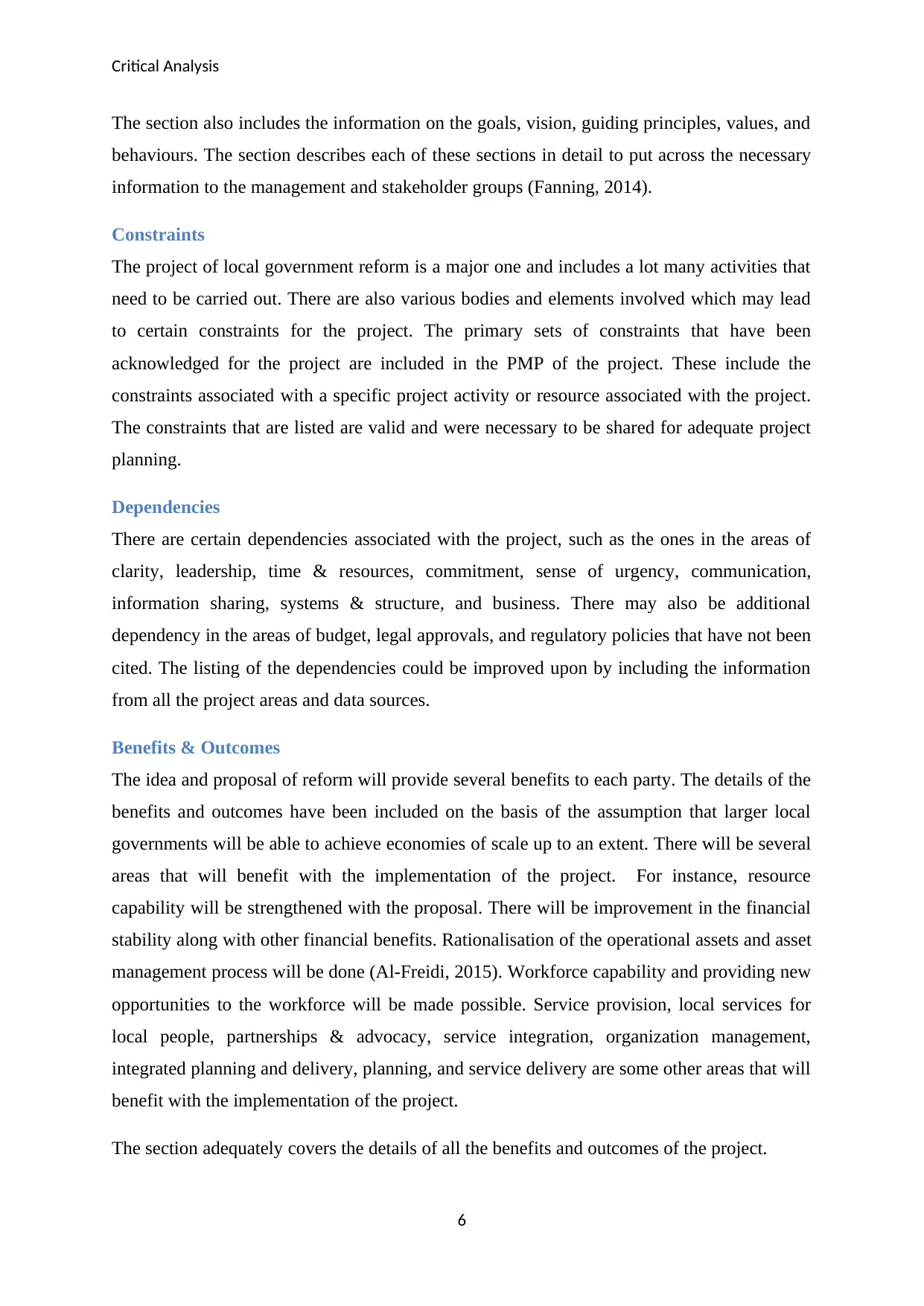
Critical Analysis
The section also includes the information on the goals, vision, guiding principles, values, and
behaviours. The section describes each of these sections in detail to put across the necessary
information to the management and stakeholder groups (Fanning, 2014).
Constraints
The project of local government reform is a major one and includes a lot many activities that
need to be carried out. There are also various bodies and elements involved which may lead
to certain constraints for the project. The primary sets of constraints that have been
acknowledged for the project are included in the PMP of the project. These include the
constraints associated with a specific project activity or resource associated with the project.
The constraints that are listed are valid and were necessary to be shared for adequate project
planning.
Dependencies
There are certain dependencies associated with the project, such as the ones in the areas of
clarity, leadership, time & resources, commitment, sense of urgency, communication,
information sharing, systems & structure, and business. There may also be additional
dependency in the areas of budget, legal approvals, and regulatory policies that have not been
cited. The listing of the dependencies could be improved upon by including the information
from all the project areas and data sources.
Benefits & Outcomes
The idea and proposal of reform will provide several benefits to each party. The details of the
benefits and outcomes have been included on the basis of the assumption that larger local
governments will be able to achieve economies of scale up to an extent. There will be several
areas that will benefit with the implementation of the project. For instance, resource
capability will be strengthened with the proposal. There will be improvement in the financial
stability along with other financial benefits. Rationalisation of the operational assets and asset
management process will be done (Al-Freidi, 2015). Workforce capability and providing new
opportunities to the workforce will be made possible. Service provision, local services for
local people, partnerships & advocacy, service integration, organization management,
integrated planning and delivery, planning, and service delivery are some other areas that will
benefit with the implementation of the project.
The section adequately covers the details of all the benefits and outcomes of the project.
6
The section also includes the information on the goals, vision, guiding principles, values, and
behaviours. The section describes each of these sections in detail to put across the necessary
information to the management and stakeholder groups (Fanning, 2014).
Constraints
The project of local government reform is a major one and includes a lot many activities that
need to be carried out. There are also various bodies and elements involved which may lead
to certain constraints for the project. The primary sets of constraints that have been
acknowledged for the project are included in the PMP of the project. These include the
constraints associated with a specific project activity or resource associated with the project.
The constraints that are listed are valid and were necessary to be shared for adequate project
planning.
Dependencies
There are certain dependencies associated with the project, such as the ones in the areas of
clarity, leadership, time & resources, commitment, sense of urgency, communication,
information sharing, systems & structure, and business. There may also be additional
dependency in the areas of budget, legal approvals, and regulatory policies that have not been
cited. The listing of the dependencies could be improved upon by including the information
from all the project areas and data sources.
Benefits & Outcomes
The idea and proposal of reform will provide several benefits to each party. The details of the
benefits and outcomes have been included on the basis of the assumption that larger local
governments will be able to achieve economies of scale up to an extent. There will be several
areas that will benefit with the implementation of the project. For instance, resource
capability will be strengthened with the proposal. There will be improvement in the financial
stability along with other financial benefits. Rationalisation of the operational assets and asset
management process will be done (Al-Freidi, 2015). Workforce capability and providing new
opportunities to the workforce will be made possible. Service provision, local services for
local people, partnerships & advocacy, service integration, organization management,
integrated planning and delivery, planning, and service delivery are some other areas that will
benefit with the implementation of the project.
The section adequately covers the details of all the benefits and outcomes of the project.
6
Paraphrase This Document
Need a fresh take? Get an instant paraphrase of this document with our AI Paraphraser
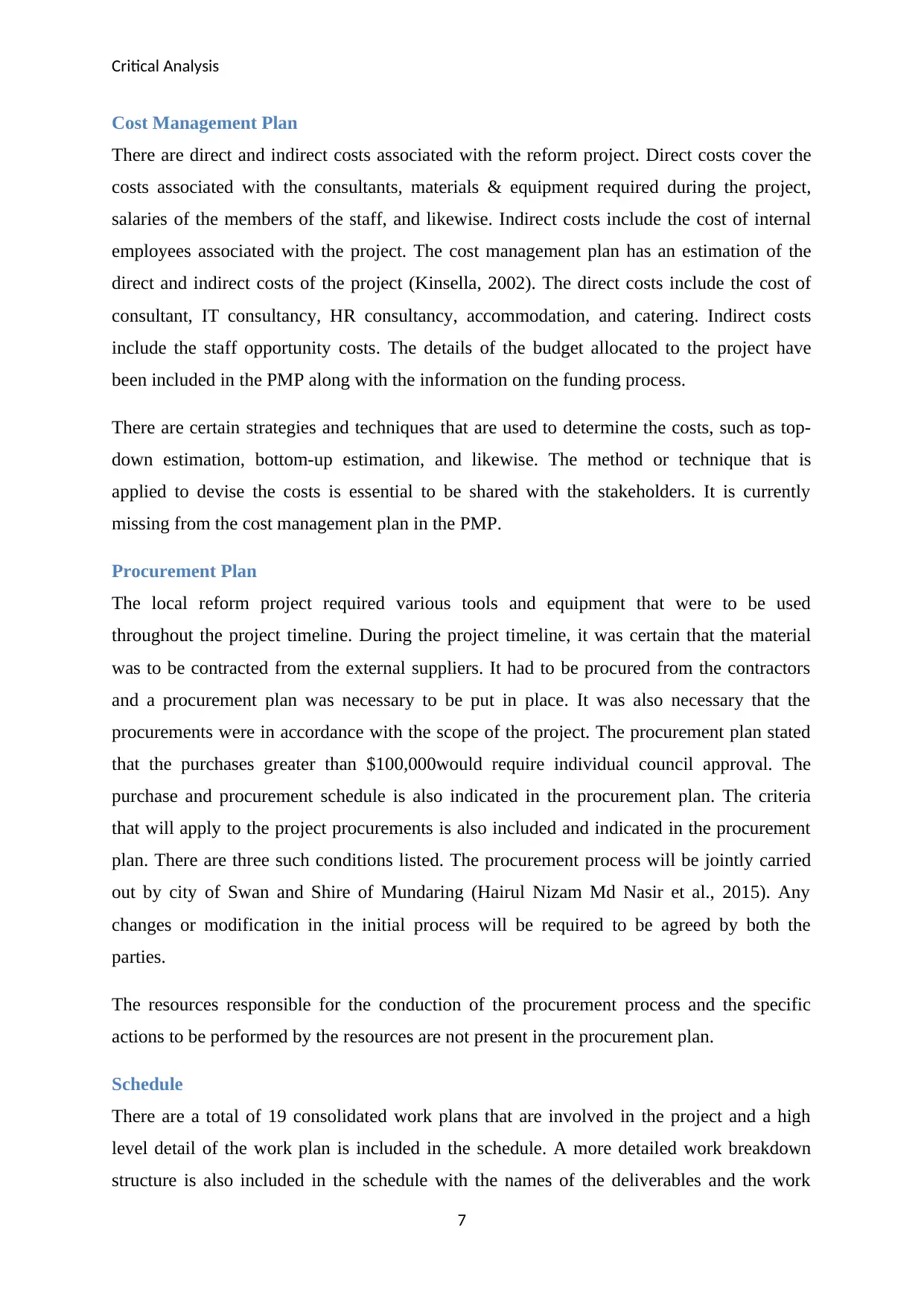
Critical Analysis
Cost Management Plan
There are direct and indirect costs associated with the reform project. Direct costs cover the
costs associated with the consultants, materials & equipment required during the project,
salaries of the members of the staff, and likewise. Indirect costs include the cost of internal
employees associated with the project. The cost management plan has an estimation of the
direct and indirect costs of the project (Kinsella, 2002). The direct costs include the cost of
consultant, IT consultancy, HR consultancy, accommodation, and catering. Indirect costs
include the staff opportunity costs. The details of the budget allocated to the project have
been included in the PMP along with the information on the funding process.
There are certain strategies and techniques that are used to determine the costs, such as top-
down estimation, bottom-up estimation, and likewise. The method or technique that is
applied to devise the costs is essential to be shared with the stakeholders. It is currently
missing from the cost management plan in the PMP.
Procurement Plan
The local reform project required various tools and equipment that were to be used
throughout the project timeline. During the project timeline, it was certain that the material
was to be contracted from the external suppliers. It had to be procured from the contractors
and a procurement plan was necessary to be put in place. It was also necessary that the
procurements were in accordance with the scope of the project. The procurement plan stated
that the purchases greater than $100,000would require individual council approval. The
purchase and procurement schedule is also indicated in the procurement plan. The criteria
that will apply to the project procurements is also included and indicated in the procurement
plan. There are three such conditions listed. The procurement process will be jointly carried
out by city of Swan and Shire of Mundaring (Hairul Nizam Md Nasir et al., 2015). Any
changes or modification in the initial process will be required to be agreed by both the
parties.
The resources responsible for the conduction of the procurement process and the specific
actions to be performed by the resources are not present in the procurement plan.
Schedule
There are a total of 19 consolidated work plans that are involved in the project and a high
level detail of the work plan is included in the schedule. A more detailed work breakdown
structure is also included in the schedule with the names of the deliverables and the work
7
Cost Management Plan
There are direct and indirect costs associated with the reform project. Direct costs cover the
costs associated with the consultants, materials & equipment required during the project,
salaries of the members of the staff, and likewise. Indirect costs include the cost of internal
employees associated with the project. The cost management plan has an estimation of the
direct and indirect costs of the project (Kinsella, 2002). The direct costs include the cost of
consultant, IT consultancy, HR consultancy, accommodation, and catering. Indirect costs
include the staff opportunity costs. The details of the budget allocated to the project have
been included in the PMP along with the information on the funding process.
There are certain strategies and techniques that are used to determine the costs, such as top-
down estimation, bottom-up estimation, and likewise. The method or technique that is
applied to devise the costs is essential to be shared with the stakeholders. It is currently
missing from the cost management plan in the PMP.
Procurement Plan
The local reform project required various tools and equipment that were to be used
throughout the project timeline. During the project timeline, it was certain that the material
was to be contracted from the external suppliers. It had to be procured from the contractors
and a procurement plan was necessary to be put in place. It was also necessary that the
procurements were in accordance with the scope of the project. The procurement plan stated
that the purchases greater than $100,000would require individual council approval. The
purchase and procurement schedule is also indicated in the procurement plan. The criteria
that will apply to the project procurements is also included and indicated in the procurement
plan. There are three such conditions listed. The procurement process will be jointly carried
out by city of Swan and Shire of Mundaring (Hairul Nizam Md Nasir et al., 2015). Any
changes or modification in the initial process will be required to be agreed by both the
parties.
The resources responsible for the conduction of the procurement process and the specific
actions to be performed by the resources are not present in the procurement plan.
Schedule
There are a total of 19 consolidated work plans that are involved in the project and a high
level detail of the work plan is included in the schedule. A more detailed work breakdown
structure is also included in the schedule with the names of the deliverables and the work
7
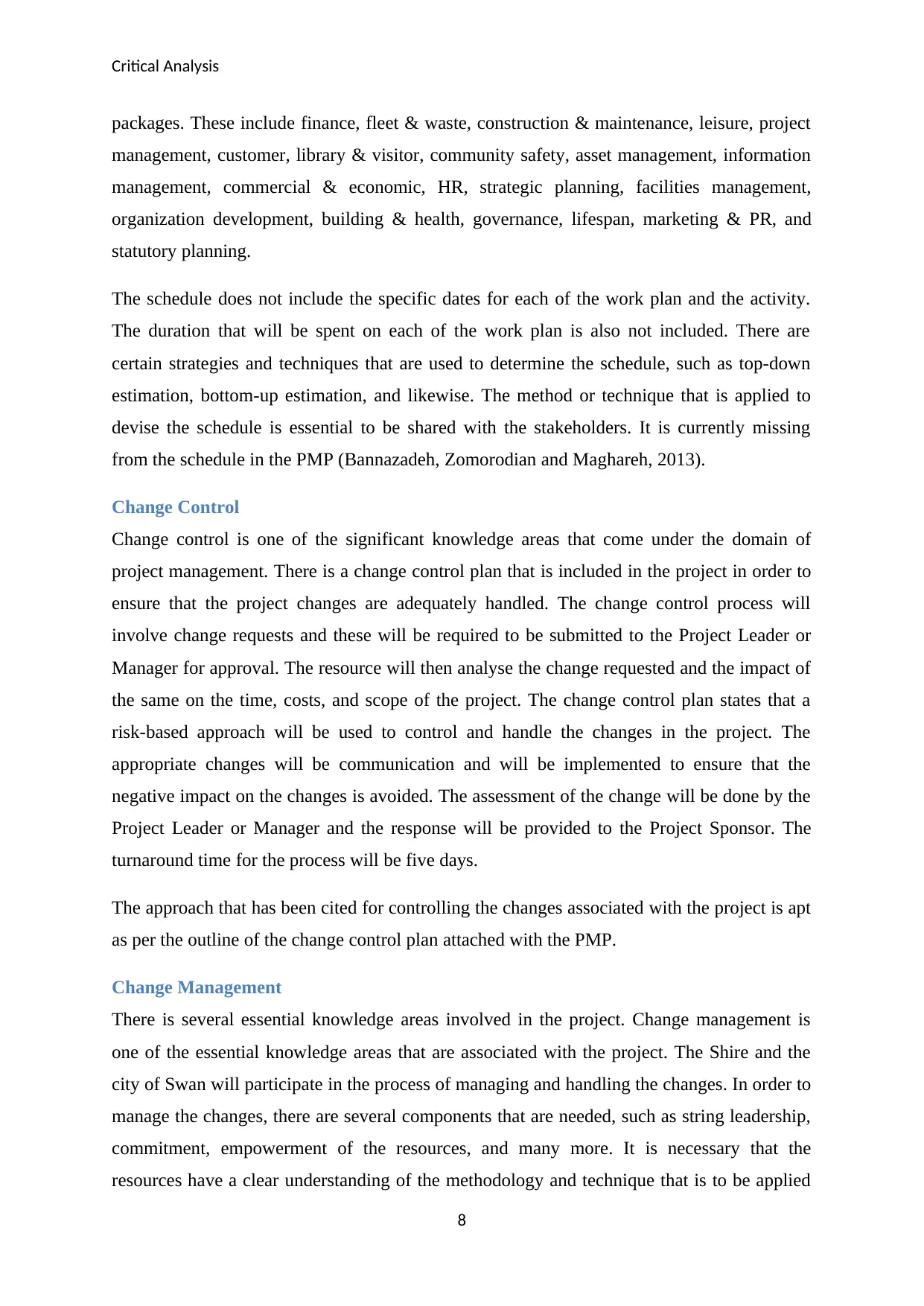
Critical Analysis
packages. These include finance, fleet & waste, construction & maintenance, leisure, project
management, customer, library & visitor, community safety, asset management, information
management, commercial & economic, HR, strategic planning, facilities management,
organization development, building & health, governance, lifespan, marketing & PR, and
statutory planning.
The schedule does not include the specific dates for each of the work plan and the activity.
The duration that will be spent on each of the work plan is also not included. There are
certain strategies and techniques that are used to determine the schedule, such as top-down
estimation, bottom-up estimation, and likewise. The method or technique that is applied to
devise the schedule is essential to be shared with the stakeholders. It is currently missing
from the schedule in the PMP (Bannazadeh, Zomorodian and Maghareh, 2013).
Change Control
Change control is one of the significant knowledge areas that come under the domain of
project management. There is a change control plan that is included in the project in order to
ensure that the project changes are adequately handled. The change control process will
involve change requests and these will be required to be submitted to the Project Leader or
Manager for approval. The resource will then analyse the change requested and the impact of
the same on the time, costs, and scope of the project. The change control plan states that a
risk-based approach will be used to control and handle the changes in the project. The
appropriate changes will be communication and will be implemented to ensure that the
negative impact on the changes is avoided. The assessment of the change will be done by the
Project Leader or Manager and the response will be provided to the Project Sponsor. The
turnaround time for the process will be five days.
The approach that has been cited for controlling the changes associated with the project is apt
as per the outline of the change control plan attached with the PMP.
Change Management
There is several essential knowledge areas involved in the project. Change management is
one of the essential knowledge areas that are associated with the project. The Shire and the
city of Swan will participate in the process of managing and handling the changes. In order to
manage the changes, there are several components that are needed, such as string leadership,
commitment, empowerment of the resources, and many more. It is necessary that the
resources have a clear understanding of the methodology and technique that is to be applied
8
packages. These include finance, fleet & waste, construction & maintenance, leisure, project
management, customer, library & visitor, community safety, asset management, information
management, commercial & economic, HR, strategic planning, facilities management,
organization development, building & health, governance, lifespan, marketing & PR, and
statutory planning.
The schedule does not include the specific dates for each of the work plan and the activity.
The duration that will be spent on each of the work plan is also not included. There are
certain strategies and techniques that are used to determine the schedule, such as top-down
estimation, bottom-up estimation, and likewise. The method or technique that is applied to
devise the schedule is essential to be shared with the stakeholders. It is currently missing
from the schedule in the PMP (Bannazadeh, Zomorodian and Maghareh, 2013).
Change Control
Change control is one of the significant knowledge areas that come under the domain of
project management. There is a change control plan that is included in the project in order to
ensure that the project changes are adequately handled. The change control process will
involve change requests and these will be required to be submitted to the Project Leader or
Manager for approval. The resource will then analyse the change requested and the impact of
the same on the time, costs, and scope of the project. The change control plan states that a
risk-based approach will be used to control and handle the changes in the project. The
appropriate changes will be communication and will be implemented to ensure that the
negative impact on the changes is avoided. The assessment of the change will be done by the
Project Leader or Manager and the response will be provided to the Project Sponsor. The
turnaround time for the process will be five days.
The approach that has been cited for controlling the changes associated with the project is apt
as per the outline of the change control plan attached with the PMP.
Change Management
There is several essential knowledge areas involved in the project. Change management is
one of the essential knowledge areas that are associated with the project. The Shire and the
city of Swan will participate in the process of managing and handling the changes. In order to
manage the changes, there are several components that are needed, such as string leadership,
commitment, empowerment of the resources, and many more. It is necessary that the
resources have a clear understanding of the methodology and technique that is to be applied
8
⊘ This is a preview!⊘
Do you want full access?
Subscribe today to unlock all pages.

Trusted by 1+ million students worldwide
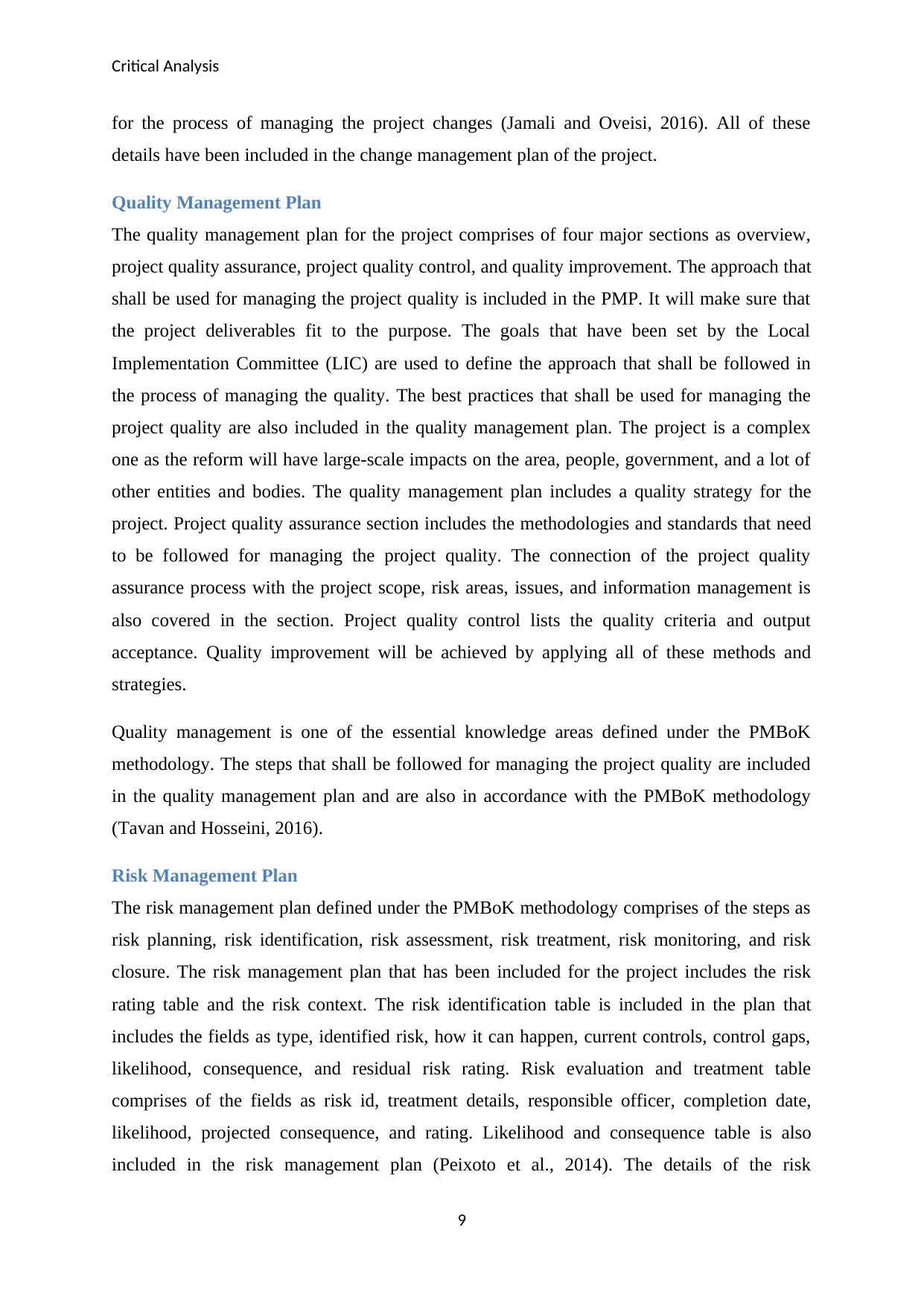
Critical Analysis
for the process of managing the project changes (Jamali and Oveisi, 2016). All of these
details have been included in the change management plan of the project.
Quality Management Plan
The quality management plan for the project comprises of four major sections as overview,
project quality assurance, project quality control, and quality improvement. The approach that
shall be used for managing the project quality is included in the PMP. It will make sure that
the project deliverables fit to the purpose. The goals that have been set by the Local
Implementation Committee (LIC) are used to define the approach that shall be followed in
the process of managing the quality. The best practices that shall be used for managing the
project quality are also included in the quality management plan. The project is a complex
one as the reform will have large-scale impacts on the area, people, government, and a lot of
other entities and bodies. The quality management plan includes a quality strategy for the
project. Project quality assurance section includes the methodologies and standards that need
to be followed for managing the project quality. The connection of the project quality
assurance process with the project scope, risk areas, issues, and information management is
also covered in the section. Project quality control lists the quality criteria and output
acceptance. Quality improvement will be achieved by applying all of these methods and
strategies.
Quality management is one of the essential knowledge areas defined under the PMBoK
methodology. The steps that shall be followed for managing the project quality are included
in the quality management plan and are also in accordance with the PMBoK methodology
(Tavan and Hosseini, 2016).
Risk Management Plan
The risk management plan defined under the PMBoK methodology comprises of the steps as
risk planning, risk identification, risk assessment, risk treatment, risk monitoring, and risk
closure. The risk management plan that has been included for the project includes the risk
rating table and the risk context. The risk identification table is included in the plan that
includes the fields as type, identified risk, how it can happen, current controls, control gaps,
likelihood, consequence, and residual risk rating. Risk evaluation and treatment table
comprises of the fields as risk id, treatment details, responsible officer, completion date,
likelihood, projected consequence, and rating. Likelihood and consequence table is also
included in the risk management plan (Peixoto et al., 2014). The details of the risk
9
for the process of managing the project changes (Jamali and Oveisi, 2016). All of these
details have been included in the change management plan of the project.
Quality Management Plan
The quality management plan for the project comprises of four major sections as overview,
project quality assurance, project quality control, and quality improvement. The approach that
shall be used for managing the project quality is included in the PMP. It will make sure that
the project deliverables fit to the purpose. The goals that have been set by the Local
Implementation Committee (LIC) are used to define the approach that shall be followed in
the process of managing the quality. The best practices that shall be used for managing the
project quality are also included in the quality management plan. The project is a complex
one as the reform will have large-scale impacts on the area, people, government, and a lot of
other entities and bodies. The quality management plan includes a quality strategy for the
project. Project quality assurance section includes the methodologies and standards that need
to be followed for managing the project quality. The connection of the project quality
assurance process with the project scope, risk areas, issues, and information management is
also covered in the section. Project quality control lists the quality criteria and output
acceptance. Quality improvement will be achieved by applying all of these methods and
strategies.
Quality management is one of the essential knowledge areas defined under the PMBoK
methodology. The steps that shall be followed for managing the project quality are included
in the quality management plan and are also in accordance with the PMBoK methodology
(Tavan and Hosseini, 2016).
Risk Management Plan
The risk management plan defined under the PMBoK methodology comprises of the steps as
risk planning, risk identification, risk assessment, risk treatment, risk monitoring, and risk
closure. The risk management plan that has been included for the project includes the risk
rating table and the risk context. The risk identification table is included in the plan that
includes the fields as type, identified risk, how it can happen, current controls, control gaps,
likelihood, consequence, and residual risk rating. Risk evaluation and treatment table
comprises of the fields as risk id, treatment details, responsible officer, completion date,
likelihood, projected consequence, and rating. Likelihood and consequence table is also
included in the risk management plan (Peixoto et al., 2014). The details of the risk
9
Paraphrase This Document
Need a fresh take? Get an instant paraphrase of this document with our AI Paraphraser
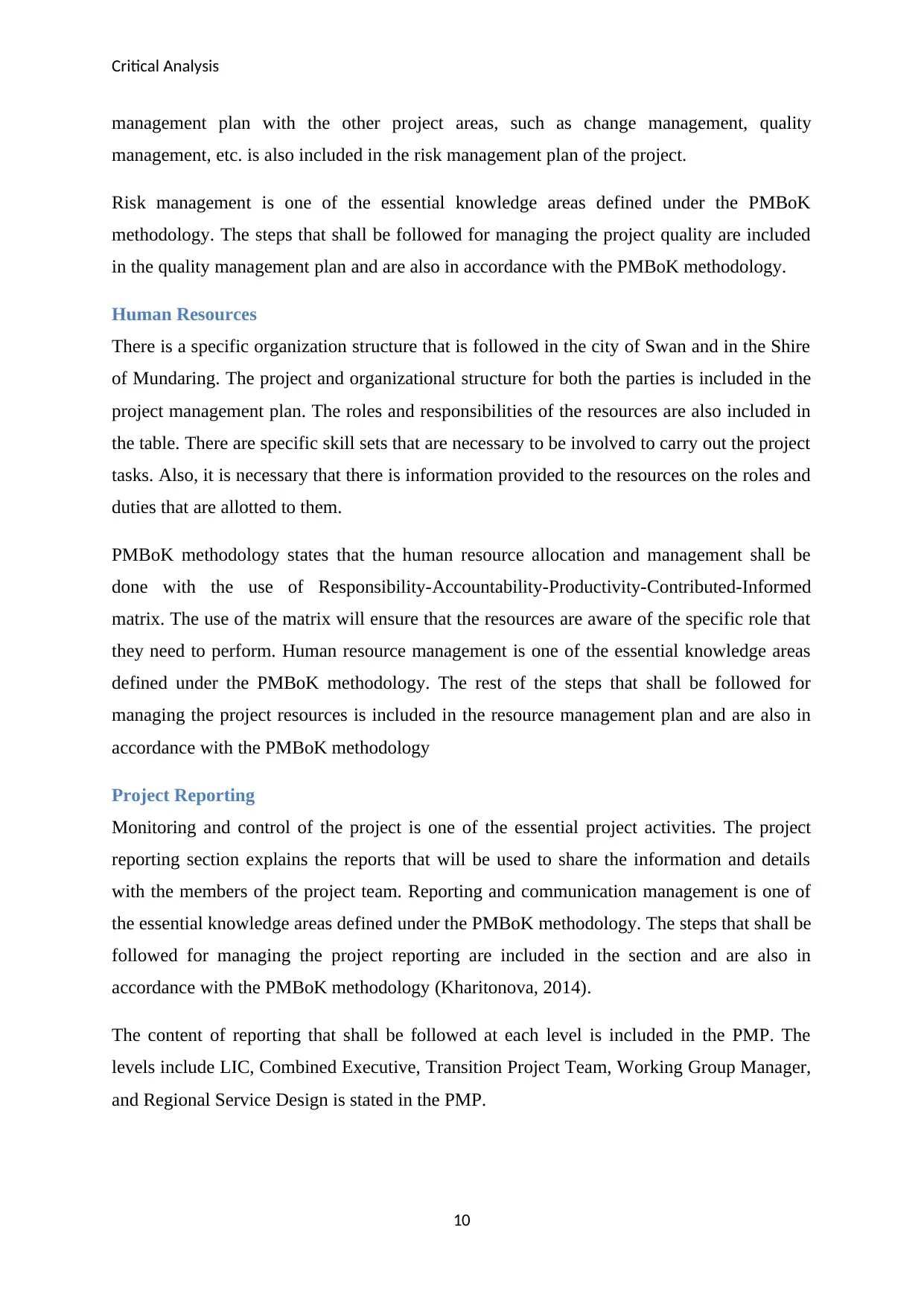
Critical Analysis
management plan with the other project areas, such as change management, quality
management, etc. is also included in the risk management plan of the project.
Risk management is one of the essential knowledge areas defined under the PMBoK
methodology. The steps that shall be followed for managing the project quality are included
in the quality management plan and are also in accordance with the PMBoK methodology.
Human Resources
There is a specific organization structure that is followed in the city of Swan and in the Shire
of Mundaring. The project and organizational structure for both the parties is included in the
project management plan. The roles and responsibilities of the resources are also included in
the table. There are specific skill sets that are necessary to be involved to carry out the project
tasks. Also, it is necessary that there is information provided to the resources on the roles and
duties that are allotted to them.
PMBoK methodology states that the human resource allocation and management shall be
done with the use of Responsibility-Accountability-Productivity-Contributed-Informed
matrix. The use of the matrix will ensure that the resources are aware of the specific role that
they need to perform. Human resource management is one of the essential knowledge areas
defined under the PMBoK methodology. The rest of the steps that shall be followed for
managing the project resources is included in the resource management plan and are also in
accordance with the PMBoK methodology
Project Reporting
Monitoring and control of the project is one of the essential project activities. The project
reporting section explains the reports that will be used to share the information and details
with the members of the project team. Reporting and communication management is one of
the essential knowledge areas defined under the PMBoK methodology. The steps that shall be
followed for managing the project reporting are included in the section and are also in
accordance with the PMBoK methodology (Kharitonova, 2014).
The content of reporting that shall be followed at each level is included in the PMP. The
levels include LIC, Combined Executive, Transition Project Team, Working Group Manager,
and Regional Service Design is stated in the PMP.
10
management plan with the other project areas, such as change management, quality
management, etc. is also included in the risk management plan of the project.
Risk management is one of the essential knowledge areas defined under the PMBoK
methodology. The steps that shall be followed for managing the project quality are included
in the quality management plan and are also in accordance with the PMBoK methodology.
Human Resources
There is a specific organization structure that is followed in the city of Swan and in the Shire
of Mundaring. The project and organizational structure for both the parties is included in the
project management plan. The roles and responsibilities of the resources are also included in
the table. There are specific skill sets that are necessary to be involved to carry out the project
tasks. Also, it is necessary that there is information provided to the resources on the roles and
duties that are allotted to them.
PMBoK methodology states that the human resource allocation and management shall be
done with the use of Responsibility-Accountability-Productivity-Contributed-Informed
matrix. The use of the matrix will ensure that the resources are aware of the specific role that
they need to perform. Human resource management is one of the essential knowledge areas
defined under the PMBoK methodology. The rest of the steps that shall be followed for
managing the project resources is included in the resource management plan and are also in
accordance with the PMBoK methodology
Project Reporting
Monitoring and control of the project is one of the essential project activities. The project
reporting section explains the reports that will be used to share the information and details
with the members of the project team. Reporting and communication management is one of
the essential knowledge areas defined under the PMBoK methodology. The steps that shall be
followed for managing the project reporting are included in the section and are also in
accordance with the PMBoK methodology (Kharitonova, 2014).
The content of reporting that shall be followed at each level is included in the PMP. The
levels include LIC, Combined Executive, Transition Project Team, Working Group Manager,
and Regional Service Design is stated in the PMP.
10
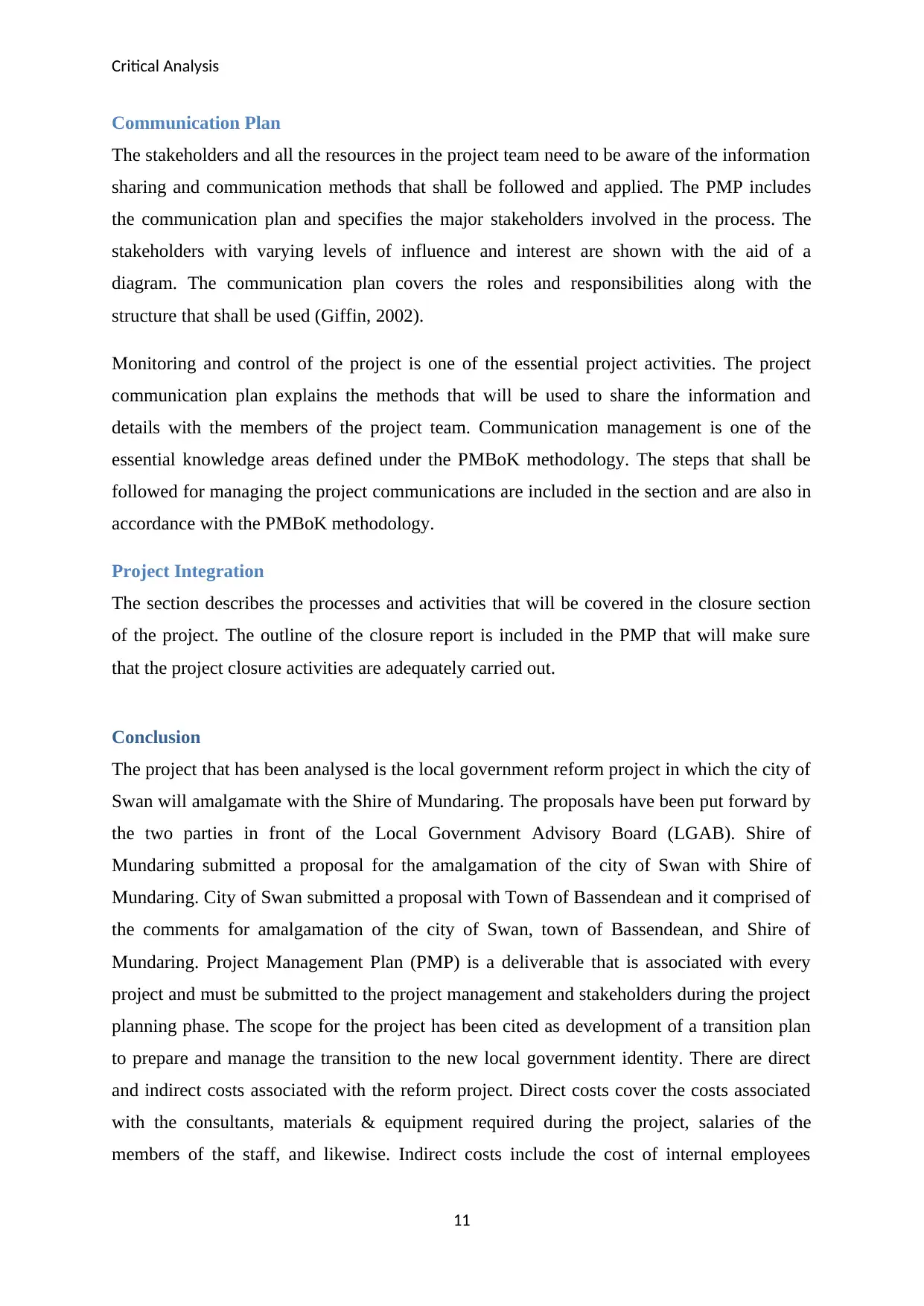
Critical Analysis
Communication Plan
The stakeholders and all the resources in the project team need to be aware of the information
sharing and communication methods that shall be followed and applied. The PMP includes
the communication plan and specifies the major stakeholders involved in the process. The
stakeholders with varying levels of influence and interest are shown with the aid of a
diagram. The communication plan covers the roles and responsibilities along with the
structure that shall be used (Giffin, 2002).
Monitoring and control of the project is one of the essential project activities. The project
communication plan explains the methods that will be used to share the information and
details with the members of the project team. Communication management is one of the
essential knowledge areas defined under the PMBoK methodology. The steps that shall be
followed for managing the project communications are included in the section and are also in
accordance with the PMBoK methodology.
Project Integration
The section describes the processes and activities that will be covered in the closure section
of the project. The outline of the closure report is included in the PMP that will make sure
that the project closure activities are adequately carried out.
Conclusion
The project that has been analysed is the local government reform project in which the city of
Swan will amalgamate with the Shire of Mundaring. The proposals have been put forward by
the two parties in front of the Local Government Advisory Board (LGAB). Shire of
Mundaring submitted a proposal for the amalgamation of the city of Swan with Shire of
Mundaring. City of Swan submitted a proposal with Town of Bassendean and it comprised of
the comments for amalgamation of the city of Swan, town of Bassendean, and Shire of
Mundaring. Project Management Plan (PMP) is a deliverable that is associated with every
project and must be submitted to the project management and stakeholders during the project
planning phase. The scope for the project has been cited as development of a transition plan
to prepare and manage the transition to the new local government identity. There are direct
and indirect costs associated with the reform project. Direct costs cover the costs associated
with the consultants, materials & equipment required during the project, salaries of the
members of the staff, and likewise. Indirect costs include the cost of internal employees
11
Communication Plan
The stakeholders and all the resources in the project team need to be aware of the information
sharing and communication methods that shall be followed and applied. The PMP includes
the communication plan and specifies the major stakeholders involved in the process. The
stakeholders with varying levels of influence and interest are shown with the aid of a
diagram. The communication plan covers the roles and responsibilities along with the
structure that shall be used (Giffin, 2002).
Monitoring and control of the project is one of the essential project activities. The project
communication plan explains the methods that will be used to share the information and
details with the members of the project team. Communication management is one of the
essential knowledge areas defined under the PMBoK methodology. The steps that shall be
followed for managing the project communications are included in the section and are also in
accordance with the PMBoK methodology.
Project Integration
The section describes the processes and activities that will be covered in the closure section
of the project. The outline of the closure report is included in the PMP that will make sure
that the project closure activities are adequately carried out.
Conclusion
The project that has been analysed is the local government reform project in which the city of
Swan will amalgamate with the Shire of Mundaring. The proposals have been put forward by
the two parties in front of the Local Government Advisory Board (LGAB). Shire of
Mundaring submitted a proposal for the amalgamation of the city of Swan with Shire of
Mundaring. City of Swan submitted a proposal with Town of Bassendean and it comprised of
the comments for amalgamation of the city of Swan, town of Bassendean, and Shire of
Mundaring. Project Management Plan (PMP) is a deliverable that is associated with every
project and must be submitted to the project management and stakeholders during the project
planning phase. The scope for the project has been cited as development of a transition plan
to prepare and manage the transition to the new local government identity. There are direct
and indirect costs associated with the reform project. Direct costs cover the costs associated
with the consultants, materials & equipment required during the project, salaries of the
members of the staff, and likewise. Indirect costs include the cost of internal employees
11
⊘ This is a preview!⊘
Do you want full access?
Subscribe today to unlock all pages.

Trusted by 1+ million students worldwide
1 out of 15
Related Documents
Your All-in-One AI-Powered Toolkit for Academic Success.
+13062052269
info@desklib.com
Available 24*7 on WhatsApp / Email
![[object Object]](/_next/static/media/star-bottom.7253800d.svg)
Unlock your academic potential
Copyright © 2020–2025 A2Z Services. All Rights Reserved. Developed and managed by ZUCOL.


